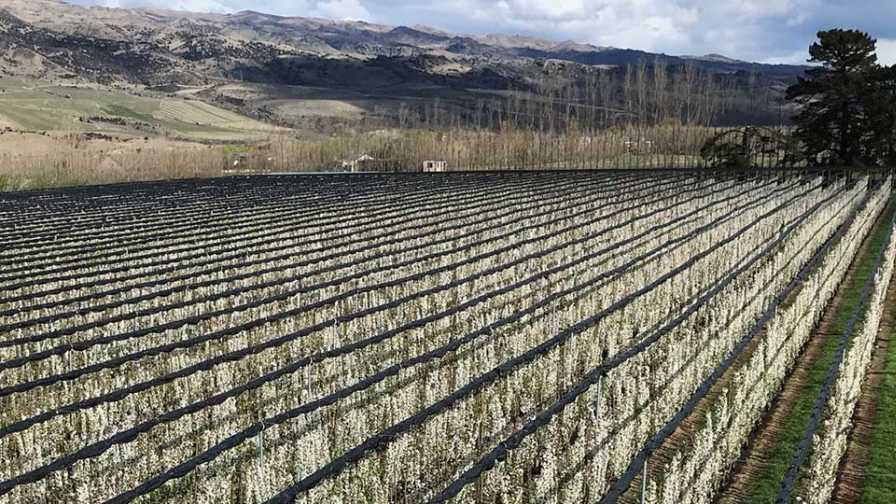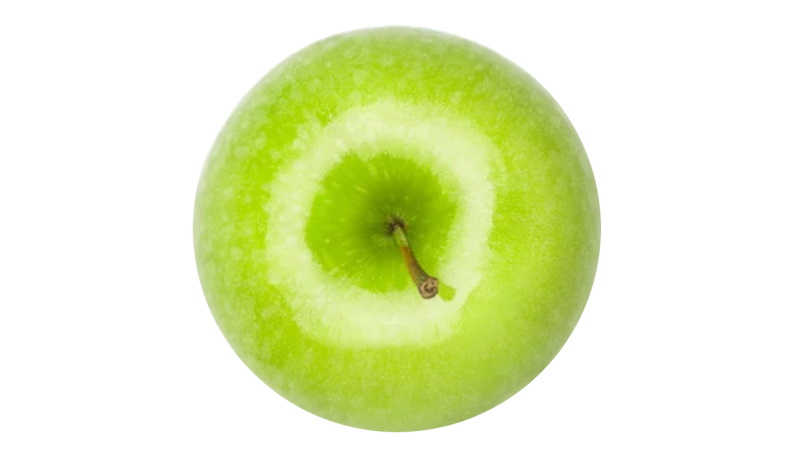Cherry Rootstock and Training Decisions: Thoughts for the 2020s

Steep leader sweet cherry trees going into their third season (January 2019, near Benton City, WA). Note the average of eight tie-downs per tree to create the first tier of fruiting wood.
Photo by Gregory Lang
The last few times I traveled through the Pacific Northwest (PNW) fruit-growing regions of the U.S., I was struck by an interesting juxtaposition. Young apple orchards with narrow, trellised rows of single- or dual-leader spindle trees at maybe 2-foot spacing were prevalent. Often, these might be adjacent to similarly young sweet cherry orchards with wide rows of multiple-leader Steep Leader trees spaced at 8 to 12 feet or more.
What a contrast! The more labor-inefficient, small-fruited species (cherry) is still being grown as a tree requiring a ladder for harvest, and the larger-fruited species (apple) is grown to be harvested by workers on a platform or, in some commercial trials now, even by a robot.
This surprised me, as I was fortunate enough to work in the Yakima Valley at Washington State University during the end of the last century, when newly available dwarfing, precocious cherry rootstocks were prompting visions of future cherry orchards that would be harvested more readily from the ground. Certainly, those visions have been realized by some growers over the past 20 years, but not as many as I would have expected by now. Why?
HAPPY AS IS
Well, clearly PNW sweet cherry growers have continued to make very good money over the past two decades with large trees that achieve high annual yields of large fruit. Compared to many cherry-growing regions, Eastern Washington’s arid, sunny climate has had a relatively low risk of damaging spring frosts and fruit-cracking rains during ripening, relatively low incidence of diseases and insect pests that are costly to manage, and relatively abundant and skilled (although increasingly expensive) labor for harvest.
In the early 2000s, there also were concerns raised by the early commercial adopters of vigor-limiting rootstocks that they caused inherently smaller fruit size. However, extensive research and grower experience has clearly shown that small fruit size is a function of crop load management — maintaining an adequate balance between leaf area and fruit numbers. Especially important for cherry trees on vigor-limiting rootstocks is late summer and fall nutrition to build nitrogen and carbohydrate storage reserves, which influence bloom and spur leaf development the following spring. Large spur leaves are essential for achieving large fruit.
In cherry-growing areas other than the PNW, where rain-cracking occurs more frequently and puts market supply (and income consistency) at risk, the future orchard business plan may require a rain-exclusion strategy. In this case, smaller precisely structured trees more readily facilitate the installation and maintenance of protective covers, and earlier yields on precocious rootstocks hasten loan repayments for such investments.
Similarly, where labor (skilled or otherwise) at harvest is less abundant, or may become less abundant in the future due to political issues, or may become more expensive in the future due to societal issues, the significant potential gains in labor efficiency with smaller and more precisely structured trees are likely to be increasingly major factors in orchard profitability during the ’20s.
ANALYZE YOUR SITE
Additional, typical considerations against smaller cherry trees include concerns about a higher proportion of the crop closer to the ground and, thus, exposure to the coldest air during radiative frost events, and the poor performance of some dwarfing rootstocks under stressful, high summer temperatures, or on shallow, sandy, rocky soils. Consequently, site selection for good air drainage and frost risk mitigation strategies, such as wind machines, are indeed important components for planning smaller-statured orchards achieved with dwarfing rootstocks or training systems.
Likewise, orchards should be located on more fertile soils if dwarfing rootstocks are to be used. Denise and Gerry Neilsen, scientists at Agri-Food Canada, clearly documented that high-frequency, low-duration irrigation and fertigation sets can significantly improve tree performance on dwarfing rootstocks. Small trees have small root systems and, thus, the provision of frequent, small amounts of water and nutrients most efficiently optimizes daily photosynthesis and leaf function for continuously supplying developing fruit with the carbohydrates and turgor pressure needed for growth.

UFO-trained cherry trees on Colt rootstock going into their sixth season (September 2020, near Cromwell, New Zealand). ‘Lapins’ yielded 9 tons per acre in the fourth season.
Photo by Ben van Gool
Conversely, if the orchard site is defined by soils with poor nutrient- and water-holding capacity, or high summer temperatures, an orchard on a semi-vigorous to vigorous rootstock should be planned. Such cherry rootstocks develop more extensive root systems, providing a greater “buffering capacity” against daily transient water stress that can shut down photosynthesis and, thus, limit fruit growth.
Where soils are fertile and high summer temperatures may be stressful, a vigorous rootstock should be combined with a vigor-diffusing training system if the business plan projects that a smaller-statured, precisely structured, labor-efficient orchard will be most profitable for the next two or more decades. Suitable training systems include KGB (Kym Green Bush) for diffusion of vigor into three-dimensional, non-trellised pedestrian orchards that can be picked without ladders, and UFO (Upright Fruiting Offshoots) for diffusion of vigor into highly structured, two-dimensional (planar) trellised orchards that facilitate partial mechanization of some pruning, training, and harvest tasks.










